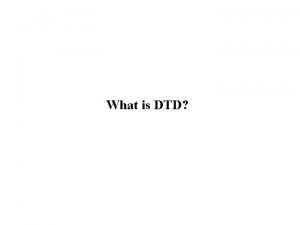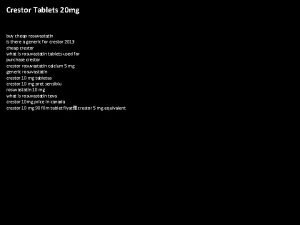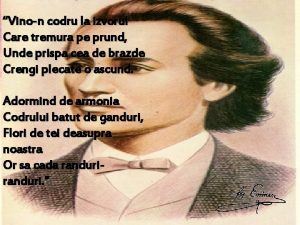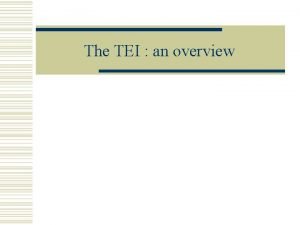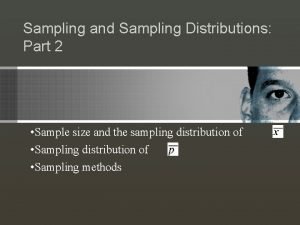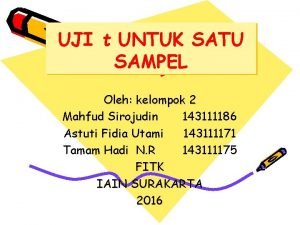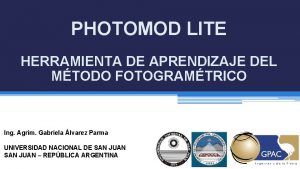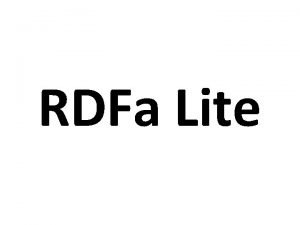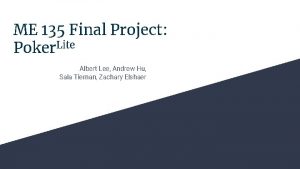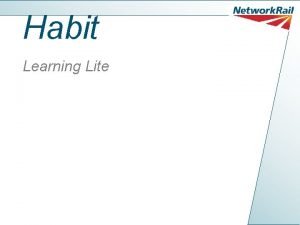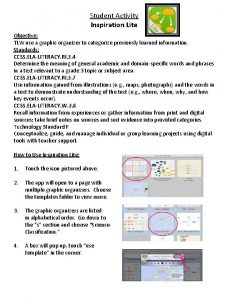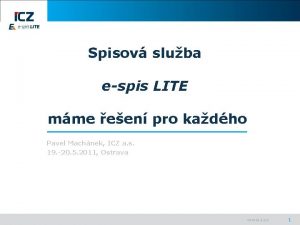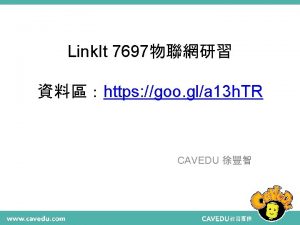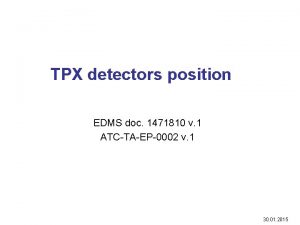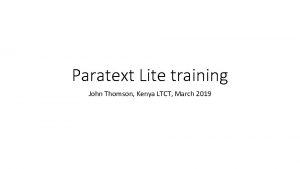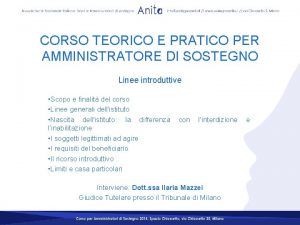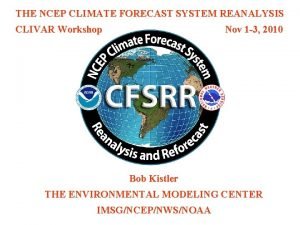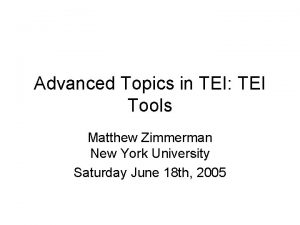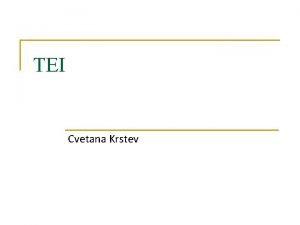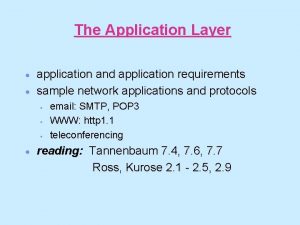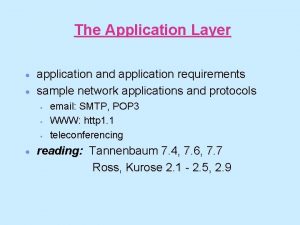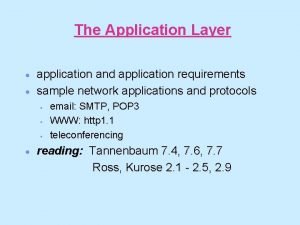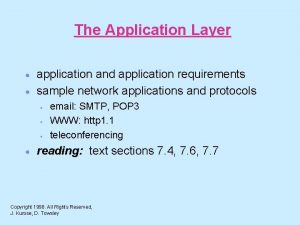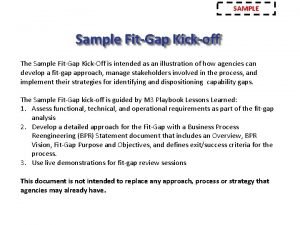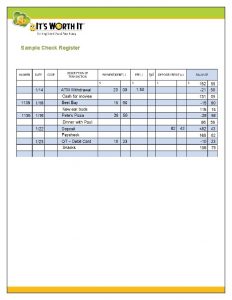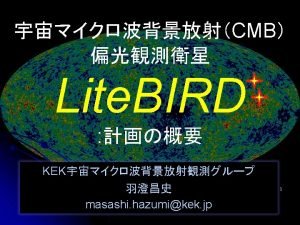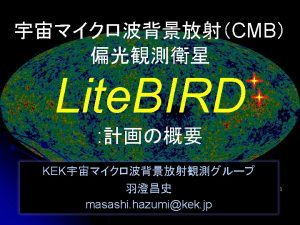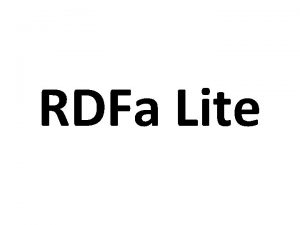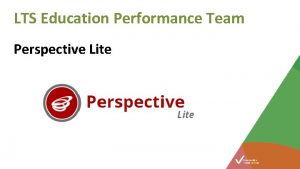TEI Lite a sample application TEI Lite w













































- Slides: 45

TEI Lite: a sample application

TEI Lite w one of many possible views of the TEI dtd w what do most people want, most of the time? w realistic for existing texts, e. g. OTA, Virginia w realistic for document production, e. g. TEI technical documentation w see http: //www. tei-c. org/Lite/

Basic structure(s) w A TEI-conformant document comprises a header followed by a text w the header contains: n n mandatory file description optional encoding, profile and revision descriptions w the header is essential for: n n bibliographic control and identification resource documentation and processing

Structure of a TEI text w A text may be unitary or composite w a unitary text contains n n n front matter back matter a body w in a composite text, the body is a group of texts (or nested groups)

TEI basic structure s tei. Corpus. 2 tei. Header TEI. 2 tei. 2 text tei. Header front group body back div text front div body back

TEI Structures Summarized w tei 2 : : tei. Header text w text : : front? (body|group) back? w group : : (text|group)+ w tei. Corpus : : tei. Header tei 2+

A text usually has divisions w generic, hierarchic subdivisions w vanilla or numbered w type attribute w associated head and trailer elements from the divtop class

for example. . . <text> <front> <!-- titlepage, etc here --> </front> <body> <div 1 type='book' n='I' id=JA 0100> <head>Book I. </head> <div 2 type='chapter' n='1' id=JA 0101> <head>Of writing lives in general, . . . <!-- remainder of chapter 1 here --> </div 2> <div 2 n='2' id=JA 0102> <!-- chapter 2 here --> </div 2> <!-- remainder of book 1 here --> </div 1> <div 1 type='book' n='II' id=JA 0200> <!-- book 2 here --> </div 1> <!-- remaining books here --> </body></text>

Use of global attributes w Applicable to all elements n n id for unique identification n for (non-unique) name or number rend for rendition (appearance) lang for language and hence writing-system w Extended by some tagsets (e. g. linking, analysis)

Character Encoding Recommendations w non normative w extend, using standard entity sets or transliteration w document transliteration scheme with formal Writing System Declaration a A 0 " b B 1 % c C 2 & d D 3 ' e E 4 ( f F 5 ) g G 6 * h H 7 + i I 8 , j k l m n o p q r s t u v w x y z J K L M N O P Q R S T U V W X Y Z 9 -. / : ; < = > ? _ (space)

Text components in TEI Lite w What are divisions composed of? n n n prose is mostly paragraphs (<p>) verse is mostly lines (<l>), sometimes in hierarchic groups (<lg>) drama is mostly speeches (<sp>) containing <p> or <l> and interspersed with stage directions (<stage>) w These may be mixed, and may also appear directly within undivided texts.

Verse: an example <lg type='haiku'> <l>Summer grass — </l> <l>all that's left</l> <l>of warriors' dreams. </l> </lg>

Drama: an example <stage>Enter Barnardo and Francisco, two Sentinels, twoat. Sentinels, at several doors</stage> several doors <sp who='Barnardo'><l>Who's there? Barnardo: Who's there? </l></sp> Francisco: Nay, answer me. Stand unfold <spyourself. who='Francisco'><l>Nay, answer me. Stand unfold yourself. </l></sp> Barnardo: Long live the king! <sp who='Barnardo'><l>Long live the Francisco: Barnardo? king! </l></sp> Barnardo: He. <sp who='Francisco'> <l>Barnardo? </l></sp> <sp who='Barnardo'><l>He. </l></sp>

Texts are not just words. . . w … but probably only people know that w an encoding may claim to capture n n n just visual salience, just its assumed causes both w encoding makes explicit one (or more) sets of interpretations

For example. . . And this Indenture further witnesseth that the said Walter Shandy, merchant, in consideration of the said intended marriage. . . <hi rend='gothic'>And this Indenture further witnesseth</hi> that the said <hi rend='italic'>Walter Shandy</hi>, merchant, in consideration of the said intended marriage. . .

…or. . . And this Indenture further witnesseth that the said Walter Shandy, merchant, in consideration of the said intended marriage. . . <seg type='formula'>And this Indenture further witnesseth</seg> that the said <name rend='italic'>Walter Shandy</name>, merchant, in consideration of the said intended marriage. . .

Who does the work? w TEI scheme allows for close reading -- and the reverse w can tag very detailed features of discourse function w can normalise or simplify (e. g. dates numbers, names) w … or leave well alone

Phrase level elements include. . . w phrases that are conventionally typographically distinct w “data-like” (names, numbers, dates, times, addresses) w editorial intervention (corrections, regularizations, additions, omissions. . . ) w cross references and links (see later)

for example. . . <head>Of writing lives in general, and particularly of <title>Pamela </title>, with a word by the bye of <name>Colley Cibber</name> and others. </head> <p>It is a trite but true observation, that <q>examples work more forcibly on the mind than precepts</q>. … <p><name>Mr. Joseph Andrews</name>, <rs>the hero of our ensuing history</rs>, was esteemed to be. . .

Direct speech w Use the who attribute to show speakers w Speeches can be nested in other speeches <q who='Wilson'>Spaulding, he came down into the office just this day eight weeks with this very paper in his hand, and he says: — <q who='Spaulding'>I wish to the Lord, Mr. Wilson, that I was a red-headed man. </q>

Foreign language phrases w The lang attribute may be attached to any element w Use <foreign> if nothing else is available w Define each language in <lang. Usage> in header Have you read <title lang='deu'>Die Dreigroschenoper </title>? <mentioned lang='fra'>Savoir-faire</mentioned> is French for know-how. John has real <foreign lang='fra'>savoirfaire</foreign>.

Names and other referring strings w The <rs> (referring string) element is used for any kind of name or reference <q>My dear <rs type='person' key='BENM 1'>Mr. Bennet</rs>, </q> said <rs type='person' key='BENM 2'> his lady</rs> to him one day, <q>have you heard that <rs type='place' key='NETP 1'> Netherfield Park</rs> is let at last? </q>

Dates, times, numbers w attributes can be used to quantify <date> and <date. Range> expressions w similarly, times <time>, <time. Range> and numbers <num> Today is <date>Tuesday 29 th</date>. Today is <date value='1994 -11 -29'>Tuesday 29 th </date>. One afternoon in <date certainty='approx' value='1994 -11'>late November. </date>. One afternoon in <date. Range from='1994 -11 -15' to='1994 -11 -30 exact='to'> late November. </date. Range>.

Correction and Regularization w <corr> and <sic> for correction (or non-correction) w <reg> and <orig> for normalization (or the reverse). . . for his nose was as sharp as a pen and <reg sic="a'">he</reg> for his nose was as sharp as a pen and <corr. . orig='table' ed=Gifford> a’ table of green feelds. babbl'd</corr> of green <reg sic='feelds'>fields</reg>

Omissions, Deletions, Additions w <gap> omission by transcriber w <del> cancellation in source or by editor w <add> or <supplied> insertion in source or by editor w <unclear> material uncertain because illegible w <damage> physical damage to text carrier

The multiple hierarchy problem w SGML allows only one hierarchy at a time w Is a document n n n chapter-paragraph-phrase gathering-page-leaf or both? w discontinuous segments w links and milestones

Boundary markers w page, column, and line breaks (<pb>, <cb>, <lb>) w generic <mile. Stone> Diana and <pb ed='ED 1' n='475'> Mary approved the step unreservedly. Dia<pb ed='ED 2' n='483'>na announced that. . .

Some chunks are also phrases w <list> lists of all kinds w <note> notes (authorial or editorial) w <figure> pictures or figures w <formula> formulae w <table> tables w <bibl> bibliographic descriptions

Lists w use <list> for lists of any kind (use type attribute to distinguish) w use <label> in two-column lists as alternative to n attribute w may be nested as necessary

for example. . . <list type=“xmas”> <label>For my true love</label> For type=“bullets”> my true love: <item><list <item>three calling * three callingbirds></item> birds <item>two* two french hens</item> french hens <item>a partridge in a pear tree<item> * a partridge in a pear tree </list></item> <label>For For. Uncle. Joe</label> Joe: <item>socks asasusual</item> socks usual </list>

Figures and graphics w The presence of a graphic is indicated by the <figure> element w The title of the graphic is tagged as a <head> w A description of the graphic may be supplied (as a <fig. Desc>) for use by software unable to render the graphic w The graphic itself is specified as an external entity

for example. . . <!ENTITY fezzi. Pic SYSTEM "fezz. gif" NDATA GIF> <figure entity=‘fezzi. Pic’> <head>Mr Fezziwig's Ball</head> <figdesc>A Cruikshank engraving showing Mr Fezziwig leading a group of revellers. </figdesc></figure>

Tables w a <table> element contains <row>s of <cell>s w spanning is indicated by rows and cols attributes w role attribute indicates whether row or column holds data or a label w embedded tables are permitted

for example. . . A three column table Row 1 123 Row 2 abc 4567 defgh <table> <row cols=‘ 3’><cell role=‘label’>A three column table </cell></row> <row><cell role=‘label’>Row 1</cell><cell>123</cell> <cell>4567</cell></row> <row><cell role=‘label’>Row 2</cell><cell>abc</cell> <cell>defgh</cell></row> </table>

Bibliography w Use simple <bibl> with optional subcomponents: n n <resp. Stmt> (for any kind of responsibility) or <author>, <editor>, etc. <title> with optional level attribute <imprint> groups publication details <bibl. Scope> adds page references etc. w Use <list. Bibl> for list of references

for example. . . <p>See for example <ref target=‘REG 92’>Regis (1992)</ref>. . <div><head>Bibliography</head> <list. Bibl> <bibl id=‘REG 92’> <author>Ed Regis</author> <title level=m>Great Mambo Chicken and the Trans. Human Experience</title> <pub. Place>London </pub. Place> <publisher>Penguin Books</publisher> <date>1992</date> <biblscope>pp 144 ff</biblscope></bibl> </list. Bibl></div>

Notes w Use <note> for notes of any kind (editorial or authorial) w if in-line, use place attribute to specify location w if out of line, either n n use target attribute to specify attachment point or mark attachment point as a <ref>

for example. . . <lg> <l>The self-same moment I could pray></l> <l>And from my neck so free</l> <l>The albatross fell off, and sank</l> <l id=“L 213”>Like lead into the sea. <note type=”auth” place=“margin”> The spell begins to break. </note> </lg>

Cross References w Use <ptr> (empty element) or <ref> (with content) w use target to specify an identifier (ID value) See especially <ref target='SEC 12'> section 12 on page 34</ref>. See especially <ptr target='SEC 12'>. . <div id='sec 12'> <head>Concerning Identifiers</head> But what if the target is not in the current document?

HTML-style pointers in TEI w new URL attribute. . . as described on <xref url=“http: //www. tei-c. org”> the TEI website</xref>. . .

TEI X-pointers w “Hy. Time for Idiots” w location ladder w 15 location types w both SGML and non-SGML based <xptr doc=“xdoc” from='step 1 step 2 step 3. . . '> to be adapted for consistency with XLink


A three way alignment <div id=E 98 lang=EN><head>The Study</head> <seg id=E 9801>The Study</seg> <seg id=E 9802>is a place</seg> <seg id=E 9803>where a Student, </seg> <div id=L 98 lang=LA> <seg id=E 9804>a part from men, </seg> <head>Musé um</head> <seg id=E 9805>sitteth alone, </seg> <seg id=L 9801>Museum</seg> <seg id=E 9806>addicted to his Studies, </seg> <seg id=L 9802>est locus</seg> <seg id=E 9807>whilst he. Studiosus, </seg> readeth</seg> <xptr n='1' id=p 981 doc=com 98> <seg id=L 9803>ubi <seg id=E 9808>Books, </seg> <xptr n='2' id=p 982 doc=com 98 <seg id=L 9804>secretus ab hominibus, from='space (2 d) (75 5) (133 75)'> <seg id=L 9805>studiis deditus, </seg> <xptr id=p 983 lectitat</seg> doc=com 98 <link. Grp type=alignment> <seg n='3' id=L 9806>dum from='space (2 d) (55 L 9801 42) (90 60)'> <link targets='E 9801 p 981'> <link targets='E 9802 <link targets='E 9803 <link targets='E 9804 <link targets='E 9805 <link targets='E 9808 </link. Grp> L 9802 '> L 9803 p 982'> L 9804 '> L 9805 '> L 9808 p 983'>

Not covered here. . . w specialised front and back matter w analytic tagging n n segmentation interpretations w the header w tags for documentation

Summary w How TEI Lite handles… n n Structural divisions Rendition vs. interpretation Phrases, chunks, and chunky phrases Pointers and links w Any dtd dealing with ordinary text will need a similar range
 Tei nummer digitalfunk
Tei nummer digitalfunk Tei dtd
Tei dtd Tei dtd
Tei dtd Proscar farmacia tei
Proscar farmacia tei Vino-n codru la izvorul
Vino-n codru la izvorul Tei lece
Tei lece Omacor tei
Omacor tei Cover letter for community facilitator
Cover letter for community facilitator Seas bonus points
Seas bonus points Job application email sample
Job application email sample Advantages of sampling
Advantages of sampling Snowball sampling example
Snowball sampling example Volunteer sample vs convenience sample
Volunteer sample vs convenience sample Cluster sampling
Cluster sampling Cluster random sampling vs stratified
Cluster random sampling vs stratified Tabel taraf signifikansi
Tabel taraf signifikansi Ncsbn clinical judgement measurement model
Ncsbn clinical judgement measurement model Sonrise lite
Sonrise lite Hecvat lite
Hecvat lite Photomod lite
Photomod lite The learning zone hampshire
The learning zone hampshire Family tree lite
Family tree lite Gartner is lite
Gartner is lite Katarzyna smalisz-skrzypczyk hematolog
Katarzyna smalisz-skrzypczyk hematolog G.lite enabled
G.lite enabled Coflex tlc calamine lite 2 layer compression kit
Coflex tlc calamine lite 2 layer compression kit Afbit lite
Afbit lite Hedex lite
Hedex lite Rdfa lite
Rdfa lite Peal soap
Peal soap Poker lite
Poker lite The good habit lite
The good habit lite Ess lite
Ess lite Caiq lite
Caiq lite Inspiration lite
Inspiration lite E spis lite
E spis lite Linkit 7697 wifi
Linkit 7697 wifi Pabg light
Pabg light Depositary & depo-lite services
Depositary & depo-lite services Lite-ng.1x001.com
Lite-ng.1x001.com Eil edms
Eil edms Paratext lite
Paratext lite Lite temeraria domanda riconvenzionale contributo unificato
Lite temeraria domanda riconvenzionale contributo unificato Art 408 cc
Art 408 cc Urinalysis program coordinator
Urinalysis program coordinator Gdas lite
Gdas lite

